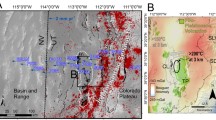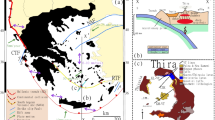Abstract
The subsurface structures of caldera ring faults are often inferred from numerical and analog models as well as from geophysical studies. All of these inferred structures need to be compared with actual ring faults so as to test the model implications. Here, we present field evidence of magma channeling into a caldera ring fault as exhibited at Hafnarfjall, a deeply eroded and well-exposed 5-Ma extinct volcano in western Iceland. At the time of collapse caldera formation, over 200 m of vertical displacement was accommodated along a ring fault, which is exceptionally well exposed at a depth of approximately 1.2 km below the original surface of the volcano. There are abrupt changes in the ring fault attitude with depth, but its overall dip is steeply inward. Several inclined sheets within the caldera became arrested at the ring fault; other sheets became deflected up along the fault to form a multiple ring dike. We present numerical models showing stress fields that encourage sheet deflection into the subvertical ring fault. Our findings provide an alternative mechanical explanation for magma channeling along caldera ring faults, which is a process likely to be fundamental in controlling the location of post-caldera volcanism.













Similar content being viewed by others
References
Acocella V, Cifelli F, Funiciello R (2000) Analogue models of collapse calderas and resurgent domes. J Volcanol Geotherm Res 104:81–96
Acocella V (2007) Understanding caldera structure and development: an overview of analogue models compared to natural calderas. Earth Sci Rev 85:125–160
Amadei B, Stephansson O (1997) Rock stress and its measurement. Chapman and Hall, New York
Anderson EM (1936) The dynamics and formation of cone-sheets, ring-dikes, and cauldron-subsidence. R Soc Edinb Proc 128–157
Anderson TL (2005) Fracture mechanics: fundamentals and applications, 3rd edn. Taylor & Francis, London, p 621
Bedard JH, Naslund HR, Nabelek P, Winpenny A, Hryciuk M, Macdonald W, Hayes B, Steigerwaldt K, Hadlari T, Rainbird R, Dewing K, Girard E (2012) Fault-mediated melt ascent in a Neoproterozoic continental flood basalt province, the Franklin sills, Victoria Island, Canada. Geol Soc Am Bull 124:723–736
Branney MJ (1995) Downsag and extension at calderas: new perspectives on collapse geometries from ice-melt, mining, and volcanic subsidence. Bull Volcanol 57:303–318
Burchardt S, Walter TR (2010) Propagation, linkage, and interaction of caldera ring-faults: comparison between analogue experiments and caldera collapse at Miyakejima, Japan, in 2000. Bull Volcanol 72:297–308
Chadwick WW, Jonsson S, Geist D, Poland M, Johnson DJ, Batt S, Harpp KS, Ruiz A (2011) The May 2005 eruption of Fernandina volcano, Galapagos: the first circumferential dike intrusion observed by GPS and InSAR. Bull Volcanol 73:679–697
Clough CTH, Maufe HB, Bailey EB (1909) The cauldron subsidence of Glen Coe and the associated igneous phenomena. Q J Geol Soc Lond 65:611–678
Delaney PT, Pollard DD, ZIony JI, McKee EH (1986) Field relations between dikes and joints: emplacement processes and paleostress analysis. J Geophys Res 91:4920–4938
Ekstrom G (1994) Anomalous earthquakes on volcano ring-fault structures. Earth Planet Sci Lett 128:707–712
Franzson H (1978) Structure and petrochemistry of the Hafnarfjall_Skardsheidi central volcano and the surrounding basalt succession, W-Iceland [Ph.D. thesis]: Edinburgh, Scotland, university of Edinburgh 264 pp
Gaffney ES, Damjanac B, Valentine GA (2007) Localization of volcanic activity: 2. Effects of pre-existing structure. Earth Planet Sci Lett 263:323–338
Gautneb H, Gudmundsson A, Oskarsson N (1989) Structure, petrochemistry and evolution of a sheet swarm in an Icelandic central volcano. Geol Mag 126:659–673
Geyer A, Folch A, Martí J (2006) Relationship between caldera collapse and magma chamber withdrawal: an experimental approach. J Volcanol Geotherm Res 157:375–386
Geyer A, Marti J (2014) A short review of our current understanding of the development of ring faults during collapse caldera formation. Front Earth Sci 2:22. doi:10.3389/feart.2014.00022
Geyer A, Martí J (2008) The new worldwide collapse caldera database (CCDB): a tool for studying and understanding caldera processes. J Volcanol Geotherm Res 175:334–354
Geshi N, Shimano T, Chiba T, Nakada S (2002) Caldera collapse during the 2000 eruption of Miyakejima volcano, Japan. Bull Volcanol 64:55–68
Giordano G, De Benedetti AA, Diana A, Diano G, Gaudioso F, Marasco F, Miceli M, Mollo S, Cas RAF, Funiciello R (2006) The Colli Albani mafic caldera (Roma, Italy): stratigraphy, structure and petrology. J Volcanol Geotherm Res 156:49–80
Gudmundsson A (1998) Formation and development of normal-fault calderas and the initiation of large explosive eruptions. Bull Volcanol 60:160–170
Gudmundsson A, Nilsen K (2006) Ring-faults in composite volcanoes: structures, models and stress fields associated with their formation. Geol Soc Lond, Spec Publ 269:83–108
Gudmundsson A, Berg SS, Lyslo KB, Skurtveit E (2011) Fracture networks and fluid transport in active fault zones. J Struct Geol 23:343–353
Gudmundsson A (2011) Rock fractures in geological processes. Cambridge University Press, Cambridge. doi:10.1017/CBO9780511975684
Gudmundsson A, Phillip SL (2006) How local stress fields prevent volcanic eruptions. J Volcanol Geotherm Res 158:257–268
Hardy S (2008) Structural evolution of calderas: insights from two-dimensional discrete element simulations. Geology 36:927
He MY, Hutchinson JW (1989) Crack deflection at an interface between dissimilar elastic materials. Int J Solids Struct 31:3443–3455
He MY, Evans AG, Hutchinson JW (1994) Crack deflection at an interface between dissimilar elastic materials. Int J Solids Struct 25:1053–1067
Holohan EP, Troll VR, Walter TR, Münn S, McDonnell S, Shipton ZK (2005) Elliptical calderas in active tectonic settings: an experimental approach. J Volcanol Geotherm Res 144:119–136
Holohan, EP., Walter, TR., Schöpfer, MPJ., Walsh, JJ., van Wyk de Vries, B. and Troll, VR. (2013). Origins of oblique-slip faulting during caldera subsidence. J Geophys Res Solid Earth, No. 2, p. n/a–n/a
Jaeger JC, Cook NGW (1979) Fundamentals of rock mechanics. Chapman and Hall, London
Johannesson H (1975) Structure and petrochemistry of the Reykjadalur central volcano and surrounding areas, midwest Iceland. PhD Thesis, University of Durham, Durham, 273 pp
Johnson SE, Schmidt KL, Tate MC (2002) Ring complexes in the Peninsula Ranges Batholith, Mexico and the USA: magma plumbing systems in the middle and upper crust. Lithos 61:187–208
Jonsson S (2009) Stress interaction between magma accumulation and trapdoor faulting on Sierra Negra volcano, Galapagos. Tectonophysics 471:36–44
Kennedy B, Stix J, Vallance JW, Lavallée Y, Longpré MA (2004) Controls on caldera structure: results from analogue sandbox modeling. Geol Soc Am Bull 116:515
Kokelaar P (2007) Friction melting, catastrophic dilation and breccia formation along caldera superfaults. J Geol Soc 164:751–754
Lipman, PW (1984) The roots of ash flow calderas in Western North America: Windows into the tops of Granitic batholiths. J Geophys Res 89:8801–8841
Lipman PW (1997) Subsidence of ash-flow calderas: relation to caldera size and magma chamber geometry. Bull Volcanol 59:198–218
Magee C, Jackson CAL, Schofield N (2013) The influence of normal fault geometry on igneous sill emplacement and morphology. Geology 41:407–410
Michon L, Villeneuve N, Catry T, Merle O (2009) How summit calderas collapse on basaltic volcanoes: new insights from the April 2007 caldera collapse of Piton de la Fournaise volcano. J Volcanol Geotherm Res 184:138–151
Newhall CG, Dzurisin D (1988) Historical unrest at large calderas of the world. US Geol Sur Bull 72:85–100
Saunders ST (2001) The shallow plumbing system of Rabaul caldera: a partially intruded ring fault? Bull Volcanol 63:406–420
Saunders ST (2004) The possible contribution of circumferential fault intrusion to caldera resurgence. Bull Volcanol 67:57–71
Smith RL, Bailey RA (1968) Resurgent cauldrons. Geol Soc Am Mem 116:613–662
Sparks RSJ (1988) Petrology and geochemistry of the Loch Ba ring-dike, Mull (NW Scotland): an example of the extreme differentiation of theolitic magmas. Contrib Mineral Petrol 100:446–461
Troll V, Walter TR, Schmincke HU (2002) Cyclic caldera collapse: piston or piecemeal subsidence? Field and experimental evidence. Geology 30:135–138. doi:10.1130/0091-7613(2002)030<0135
Tucker D, Hildreth W, Ullrich T, Friedman R (2007) Geology and complex collapse mechanisms of the 3.72 Ma Hannegan caldera, North Cascades, Washington, USA. Geol Soc Am Bull 119:329–342. doi:10.1130/825904.1
Valentine GA, Krogh KEC (2006) Emplacement of shallow dikes and sills beneath a small basaltic volcanic center—the role of pre-existing structure (Paiute Ridge, southern Nevada, USA). Earth Planet Sci Lett 246:217–230
Walker GPL (1960) Zeolite zones and dike distribution in relation to the structure of the basalts of eastern Iceland. J Geol Soc 68:515–527
Walker GPL (1984) Downsag calderas, ring faults, caldera sizes, and incremental growth. J Geophys Res 89:8407–8416
Walter TR (2008)Facilitating dike intrusions into ring-faults. In: Gottsmann J, Joan Martí (eds) Caldera volcanism: analysis, modelling and response, vol 10. Elsevier, Heidelberg, pp 351–374
Walter TR, Troll VR (2011) Formation of caldera periphery faults: an experimental study. Bull Volcanol 63:191–203
Wang P, Xu LR (2006) Dynamic interfacial debonding initiation induced by an incident crack. Int J Solids Struct 43(21):6535–6550
Xu LR, Huang YY, Rosakis AJ (2003) Dynamic crack deflection and penetration at interfaces in homogeneous materials: experimental studies and model predictions. J Mech Phys Solids 51:461–486
Ziv A, Rubin AM (2000) Stability of dike intrusion along pre-existing fractures. J Geophys Res 105
Acknowledgments
Fieldwork of JB was partly funded by the geologists’ association Baker-Arber Fund. We would like to thank Adelina Geyer and an anonymous reviewer for their very helpful comments. We also thank the editor Guido Giordano for his helpful suggestions. We are grateful to Hjalti Franzson for providing his geological map of the area and advice on field exposures, Hannah Reynolds and Zoe Barnett for field assistance, and Jonathan Pownall for fruitful discussion.
Author information
Authors and Affiliations
Corresponding author
Additional information
Editorial responsibility: G. Giordano
Electronic supplementary material
Below is the link to the electronic supplementary material.
ESM 1
As the stresses around a propagating dike tip are dynamic, we include here a model run which simulates the continuation of a dike into the fault zone. Once the sheet has deflected into a vertical dike then the stresses around leading edge of the dike favor vertical propagation (PDF 466 kb)
Rights and permissions
About this article
Cite this article
Browning, J., Gudmundsson, A. Caldera faults capture and deflect inclined sheets: an alternative mechanism of ring dike formation. Bull Volcanol 77, 4 (2015). https://doi.org/10.1007/s00445-014-0889-4
Received:
Accepted:
Published:
DOI: https://doi.org/10.1007/s00445-014-0889-4




